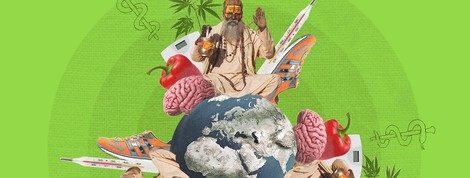Your podcast discovery platform
Curious minds select the most fascinating podcasts from around the world. Discover hand-piqd audio recommendations on your favorite topics.

piqer for: Global finds Health and Sanity Doing Good
Bangalore-based Rashmi Vasudeva's journalism has appeared in many Indian and international publications over the past decade. A features writer with over nine years of experience heading a health and fitness supplement in a mainstream Indian newspaper, her niche areas include health, wellness, fitness, food, nutrition and Indian classical Arts.
Her articles have appeared in various publications including Mint-Wall Street Journal, The Hindu, Deccan Herald (mainstream South Indian newspaper), Smart Life (Health magazine from the Malayala Manorama Group of publications), YourStory (India's media technology platform for entrepreneurs), Avantika (a noir arts and theatre magazine), ZDF (a German public broadcasting company) and others.
In 2006, she was awarded the British Print-Chevening scholarship to pursue a short-term course in new-age journalism at the University of Westminster, U.K. With a double Masters in Globalisation and Media Studies from Aarhus Universitet (Denmark), University of Amsterdam and Swansea University in Wales, U.K., she has also dabbled in academics, travel writing and socio-cultural studies. Mother to a frisky toddler, she hums 'wheels on the bus' while working and keeps a beady eye on the aforementioned toddler's antics.
The Elusive Cure For Chronic Back Pain Might Lie In The Brain (And Not The Spine)
Back pain cure is an industry. But, for patients, the experience is often acutely unproductive and their journey is marked by years of chronic pain, frustration and an ever-elusive relief.
Treatment is mostly about pain management through pills, bed rest and surgery — often at prohibitive costs — forcing doctors to consider alternative solutions and work on a deeper understanding of the sources of back pain.
The author of Crooked: Outwitting the Back Pain Industry writes it is now clear that back pain is not as much a structural issue as it was historically imagined to be — the pain is often generated in the central nervous system and stays within the brain. During her eight-year professional and personal journey with back pain, she made another surprising discovery: “...the correlation between symptoms and imaging was poor, and yet tens of thousands of spinal MRIs were ordered every year...” Spinal MRIs are usually the first (expensive) stop — next is surgery.
In the US alone, 80,000 spine procedures fail every year; often, patients continue to be on painkillers after a ‘successful’ surgery, second attempts are equally fruitless and all of it costs a fortune, not to mention the physical and mental trauma a patient undergoes and the obvious loss of productivity.
The recent revelation that the anatomy of the human brain in patients who suffered from chronic pain was ‘abnormal’ and is structurally different may throw more light on why such a large percentage of back surgeries are ineffective.
A serendipitously parallel article in the Scientific American discusses how exercise might be one of the best remedies to reduce chronic back pain and improve mobility “in light of the limited efficacy of surgical intervention”. Interestingly, this essay too discusses at length moving away from 'spare your back' and 'be careful' advisories to strengthening it physically through supervised movement and getting past the terror of pain in our brains.
